Detailed Analysis of Sources of Funds for ANZ and Commonwealth Bank
VerifiedAdded on 2022/10/17
|21
|3548
|244
Report
AI Summary
This report provides a comprehensive analysis of the sources of funds utilized by ANZ Bank and Commonwealth Bank. It begins with an abstract outlining the importance of external funding for corporate expansion, research, and competitive advantage. The report then delves into the specifics of owner's equity, including items like ordinary share capital, reserves, and retained earnings, and tracks movements in these items over a three-year period for both banks. The analysis extends to liabilities, categorizing them as short-term or long-term and examining their components, such as deposits, borrowings, and various provisions. The report further discusses the advantages and disadvantages of different funding sources, differentiating between internal, ownership, and non-ownership capital. Finally, the report clarifies the concepts of small and large proprietary companies and the implications of these classifications on compliance and reporting requirements. The report concludes by summarizing the key findings and providing references for further study.

Running head: REPORT 1
Corporate and Financial accounting
Student details:
9/24/2019
Corporate and Financial accounting
Student details:
9/24/2019
Paraphrase This Document
Need a fresh take? Get an instant paraphrase of this document with our AI Paraphraser
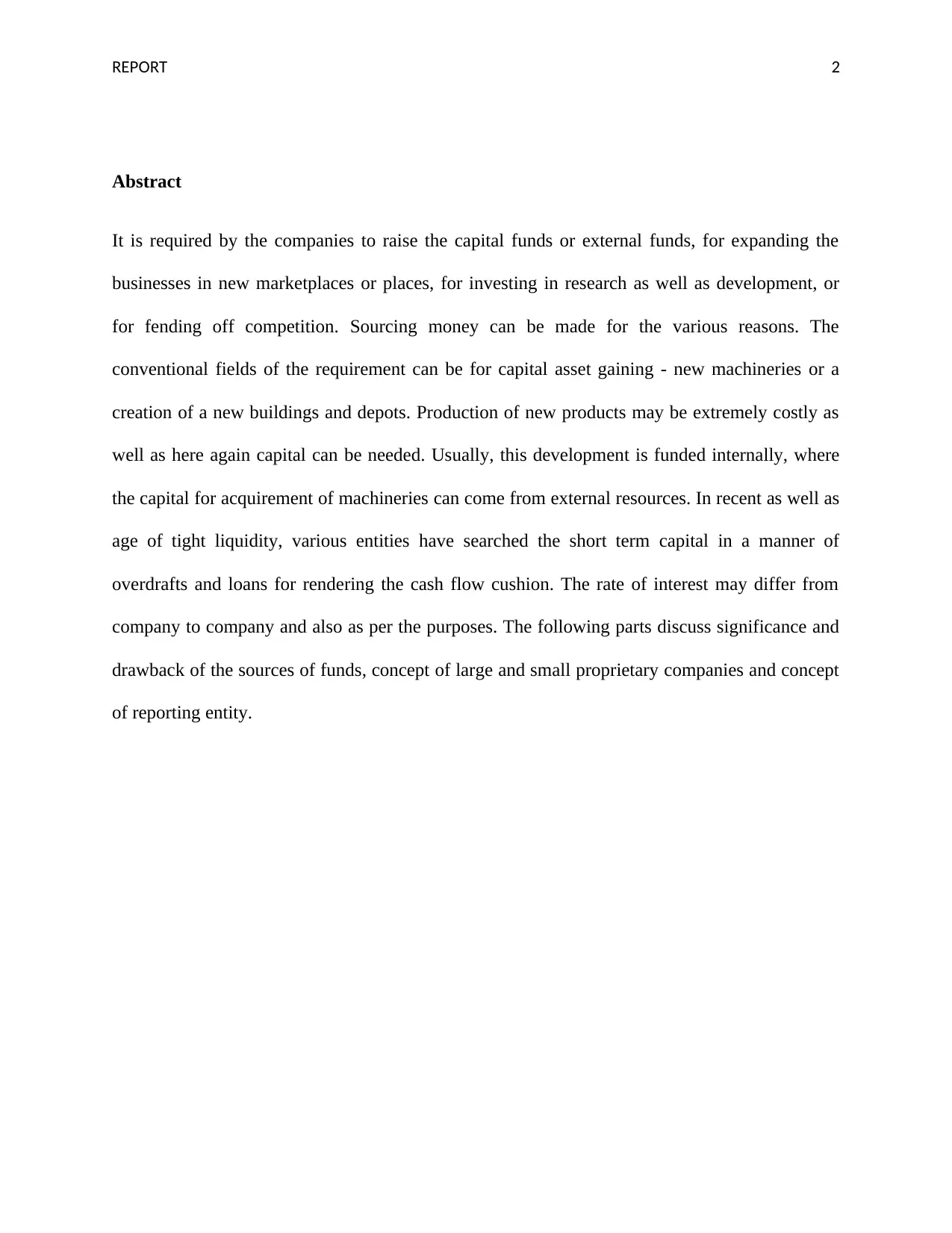
REPORT 2
Abstract
It is required by the companies to raise the capital funds or external funds, for expanding the
businesses in new marketplaces or places, for investing in research as well as development, or
for fending off competition. Sourcing money can be made for the various reasons. The
conventional fields of the requirement can be for capital asset gaining - new machineries or a
creation of a new buildings and depots. Production of new products may be extremely costly as
well as here again capital can be needed. Usually, this development is funded internally, where
the capital for acquirement of machineries can come from external resources. In recent as well as
age of tight liquidity, various entities have searched the short term capital in a manner of
overdrafts and loans for rendering the cash flow cushion. The rate of interest may differ from
company to company and also as per the purposes. The following parts discuss significance and
drawback of the sources of funds, concept of large and small proprietary companies and concept
of reporting entity.
Abstract
It is required by the companies to raise the capital funds or external funds, for expanding the
businesses in new marketplaces or places, for investing in research as well as development, or
for fending off competition. Sourcing money can be made for the various reasons. The
conventional fields of the requirement can be for capital asset gaining - new machineries or a
creation of a new buildings and depots. Production of new products may be extremely costly as
well as here again capital can be needed. Usually, this development is funded internally, where
the capital for acquirement of machineries can come from external resources. In recent as well as
age of tight liquidity, various entities have searched the short term capital in a manner of
overdrafts and loans for rendering the cash flow cushion. The rate of interest may differ from
company to company and also as per the purposes. The following parts discuss significance and
drawback of the sources of funds, concept of large and small proprietary companies and concept
of reporting entity.
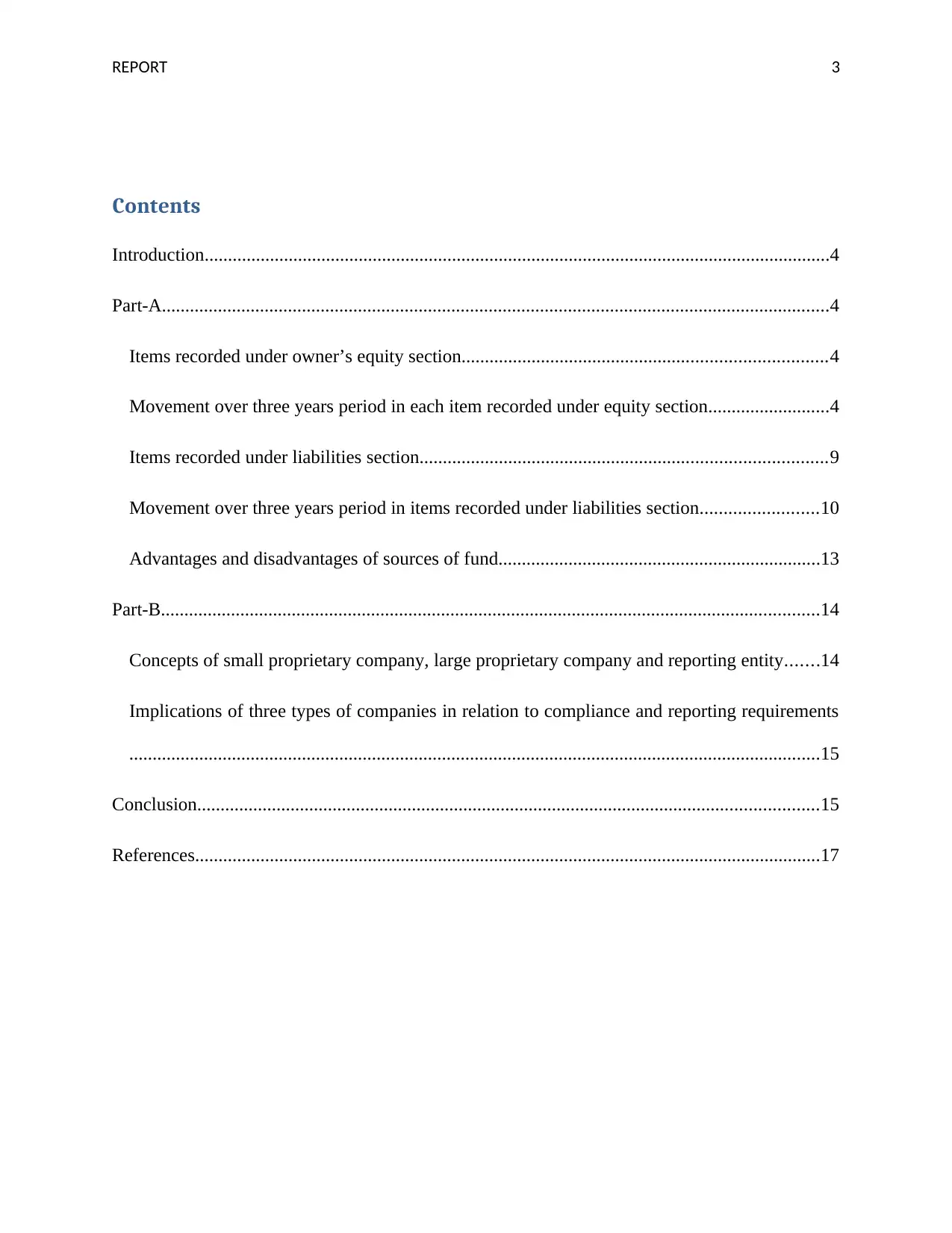
REPORT 3
Contents
Introduction......................................................................................................................................4
Part-A...............................................................................................................................................4
Items recorded under owner’s equity section..............................................................................4
Movement over three years period in each item recorded under equity section..........................4
Items recorded under liabilities section.......................................................................................9
Movement over three years period in items recorded under liabilities section.........................10
Advantages and disadvantages of sources of fund.....................................................................13
Part-B.............................................................................................................................................14
Concepts of small proprietary company, large proprietary company and reporting entity.......14
Implications of three types of companies in relation to compliance and reporting requirements
....................................................................................................................................................15
Conclusion.....................................................................................................................................15
References......................................................................................................................................17
Contents
Introduction......................................................................................................................................4
Part-A...............................................................................................................................................4
Items recorded under owner’s equity section..............................................................................4
Movement over three years period in each item recorded under equity section..........................4
Items recorded under liabilities section.......................................................................................9
Movement over three years period in items recorded under liabilities section.........................10
Advantages and disadvantages of sources of fund.....................................................................13
Part-B.............................................................................................................................................14
Concepts of small proprietary company, large proprietary company and reporting entity.......14
Implications of three types of companies in relation to compliance and reporting requirements
....................................................................................................................................................15
Conclusion.....................................................................................................................................15
References......................................................................................................................................17
⊘ This is a preview!⊘
Do you want full access?
Subscribe today to unlock all pages.

Trusted by 1+ million students worldwide

REPORT 4
Introduction
When the corporations aim to utilize the profits from business functions to fund like projects, this
is regularly more favorable for companies to look for external investors as well as lenders. In
spite of the differences amongst numerous organizations everywhere in the world across
numerous industries, there are some sources of fund accessible to entities. The sources of
funds for the business are debt, equity, debenture, term-loan, letter of credit, retained earnings,
working capital loan, as well as venture-funds and others (cremers, et. al, 2016). All sources of
funds can be useful in different conditions. They are categorized as per the period, and
regulation, ownership along with the generation’s sources. In the following parts, different
sources of fund used by Commonwealth Bank and ANZ bank is discussed and critically
examined. The first also recognizes the movement over the three periods in the sources of funds
used by Commonwealth Bank and ANZ bank. The second part also states the concept of small
proprietary company, large proprietary company and reporting entity, and implications of them
in relation to compliance as well reporting requirements.
Part-A
Items recorded under owner’s equity section
The owner's equity or shareholder’s equity is described as a proportion of total value of the
assets of corporation, which may be claimed by the owners such as partner sole proprietor. The
owner's or shareholder’s equity is considered (along with liability) as the business asset’s source.
Introduction
When the corporations aim to utilize the profits from business functions to fund like projects, this
is regularly more favorable for companies to look for external investors as well as lenders. In
spite of the differences amongst numerous organizations everywhere in the world across
numerous industries, there are some sources of fund accessible to entities. The sources of
funds for the business are debt, equity, debenture, term-loan, letter of credit, retained earnings,
working capital loan, as well as venture-funds and others (cremers, et. al, 2016). All sources of
funds can be useful in different conditions. They are categorized as per the period, and
regulation, ownership along with the generation’s sources. In the following parts, different
sources of fund used by Commonwealth Bank and ANZ bank is discussed and critically
examined. The first also recognizes the movement over the three periods in the sources of funds
used by Commonwealth Bank and ANZ bank. The second part also states the concept of small
proprietary company, large proprietary company and reporting entity, and implications of them
in relation to compliance as well reporting requirements.
Part-A
Items recorded under owner’s equity section
The owner's equity or shareholder’s equity is described as a proportion of total value of the
assets of corporation, which may be claimed by the owners such as partner sole proprietor. The
owner's or shareholder’s equity is considered (along with liability) as the business asset’s source.
Paraphrase This Document
Need a fresh take? Get an instant paraphrase of this document with our AI Paraphraser

REPORT 5
The major elements of the shareholder’s equity (owner’s equity) cover the retained earnings,
outstanding shares, treasury stock as well as additional paid up capital (Carini, 2018).
From the annual report of ANZ Bank, it is analyzed that there are some items are recorded under
owner’s equity. These items are ordinary share capital, reserves as well as retained earnings. It is
stated that Shares capital and reserve distributed to stakeholders of an organization, and non-
controlling interest are also recorded under the Owner’s equity or shareholder’s equity.
Furthermore, when Commonwealth Bank’s annual report is analyzed, this is found that items
recorded under the owner or owner’s equity are reserves, retained profits along with ordinary
share-capital. In addition, non-controlling interest as well as shareholders’ Equity distributed to
Equity holders is also covered under owner’s equity (Suryanta, 2016).
Movement over three years period in each item recorded under equity section
The main accounts, which affect the owner's equity, include revenue, expense, gain as well as the
loss. The owner's equity would enhance in case of having gains as well as revenues. The owner's
equity reduces in case of incurring losses as well as expenditures (Allashel, 2015). In a case,
when the liabilities become higher than the assets, the company would have the negative owner's
equity. The movement over three years in items recorded under equity is explained below-
Commonwealth Bank-
The major elements of the shareholder’s equity (owner’s equity) cover the retained earnings,
outstanding shares, treasury stock as well as additional paid up capital (Carini, 2018).
From the annual report of ANZ Bank, it is analyzed that there are some items are recorded under
owner’s equity. These items are ordinary share capital, reserves as well as retained earnings. It is
stated that Shares capital and reserve distributed to stakeholders of an organization, and non-
controlling interest are also recorded under the Owner’s equity or shareholder’s equity.
Furthermore, when Commonwealth Bank’s annual report is analyzed, this is found that items
recorded under the owner or owner’s equity are reserves, retained profits along with ordinary
share-capital. In addition, non-controlling interest as well as shareholders’ Equity distributed to
Equity holders is also covered under owner’s equity (Suryanta, 2016).
Movement over three years period in each item recorded under equity section
The main accounts, which affect the owner's equity, include revenue, expense, gain as well as the
loss. The owner's equity would enhance in case of having gains as well as revenues. The owner's
equity reduces in case of incurring losses as well as expenditures (Allashel, 2015). In a case,
when the liabilities become higher than the assets, the company would have the negative owner's
equity. The movement over three years in items recorded under equity is explained below-
Commonwealth Bank-
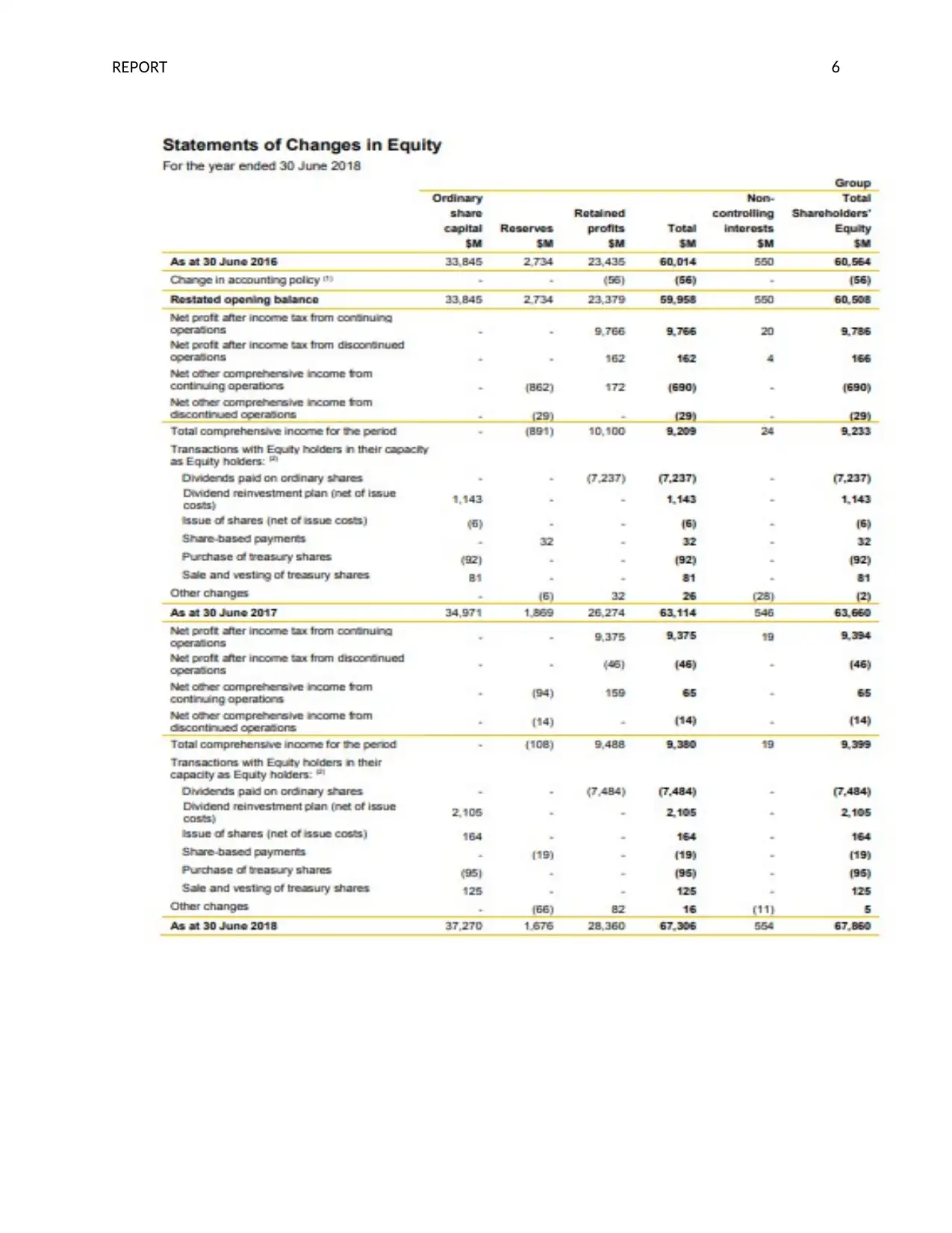
REPORT 6
⊘ This is a preview!⊘
Do you want full access?
Subscribe today to unlock all pages.

Trusted by 1+ million students worldwide
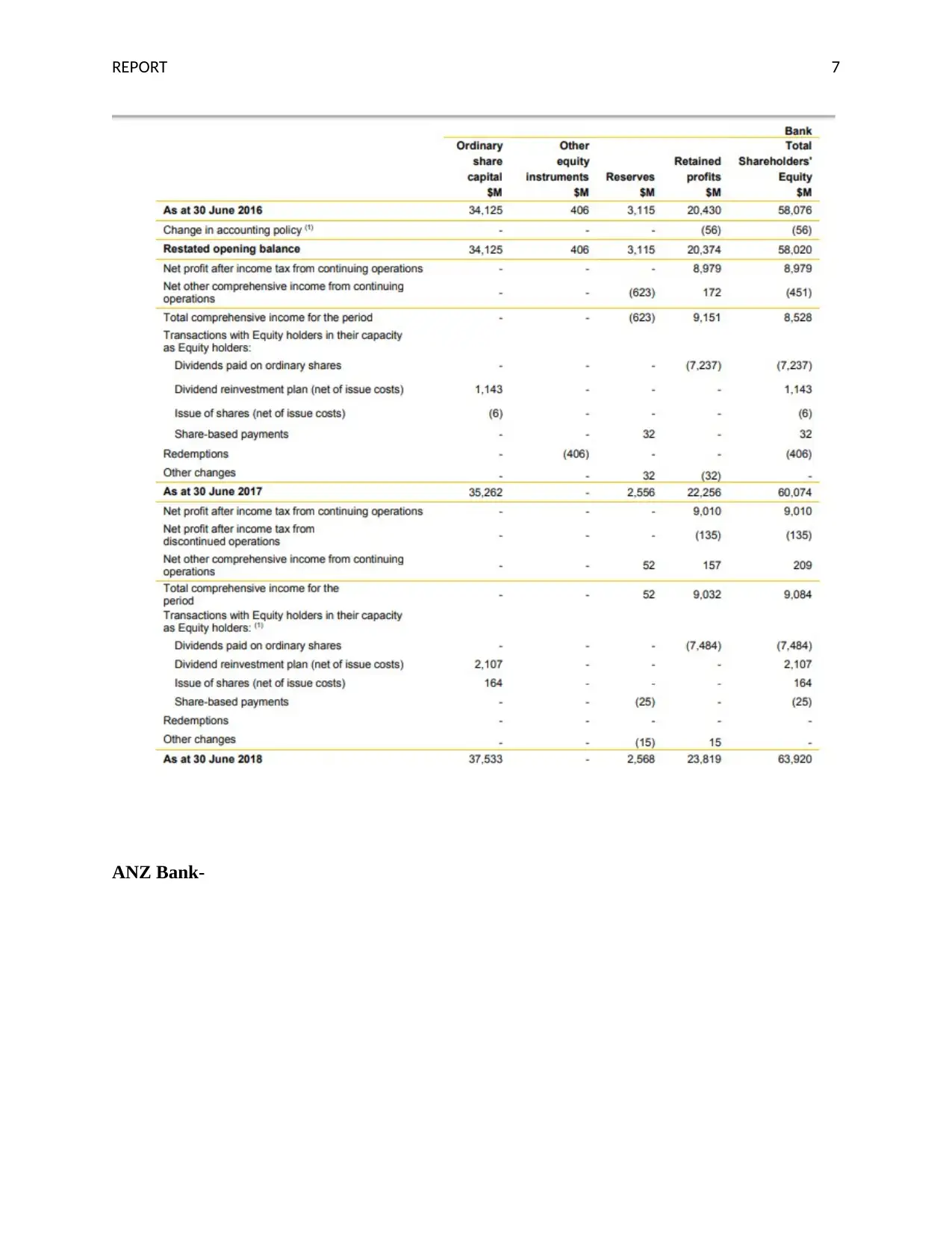
REPORT 7
ANZ Bank-
ANZ Bank-
Paraphrase This Document
Need a fresh take? Get an instant paraphrase of this document with our AI Paraphraser
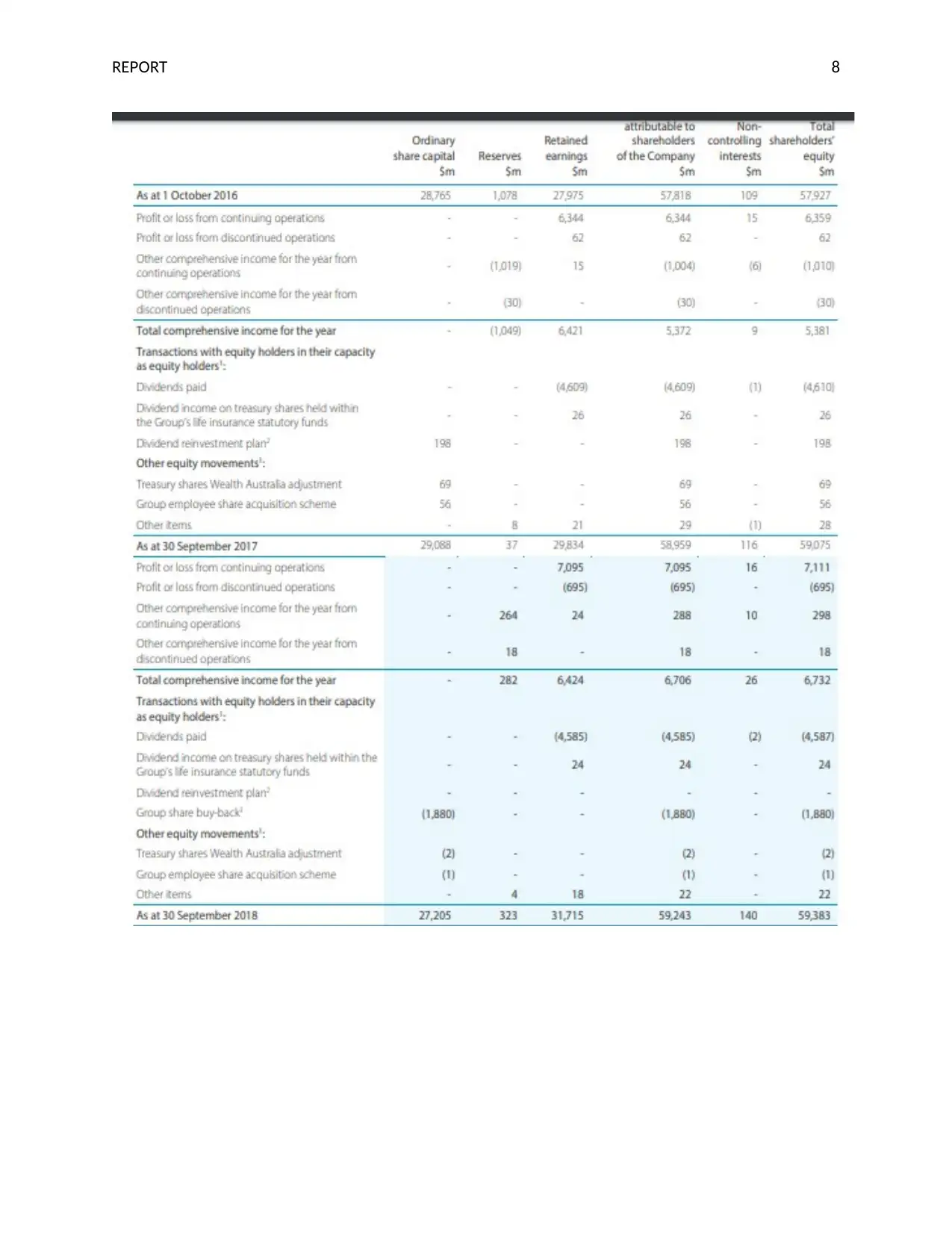
REPORT 8
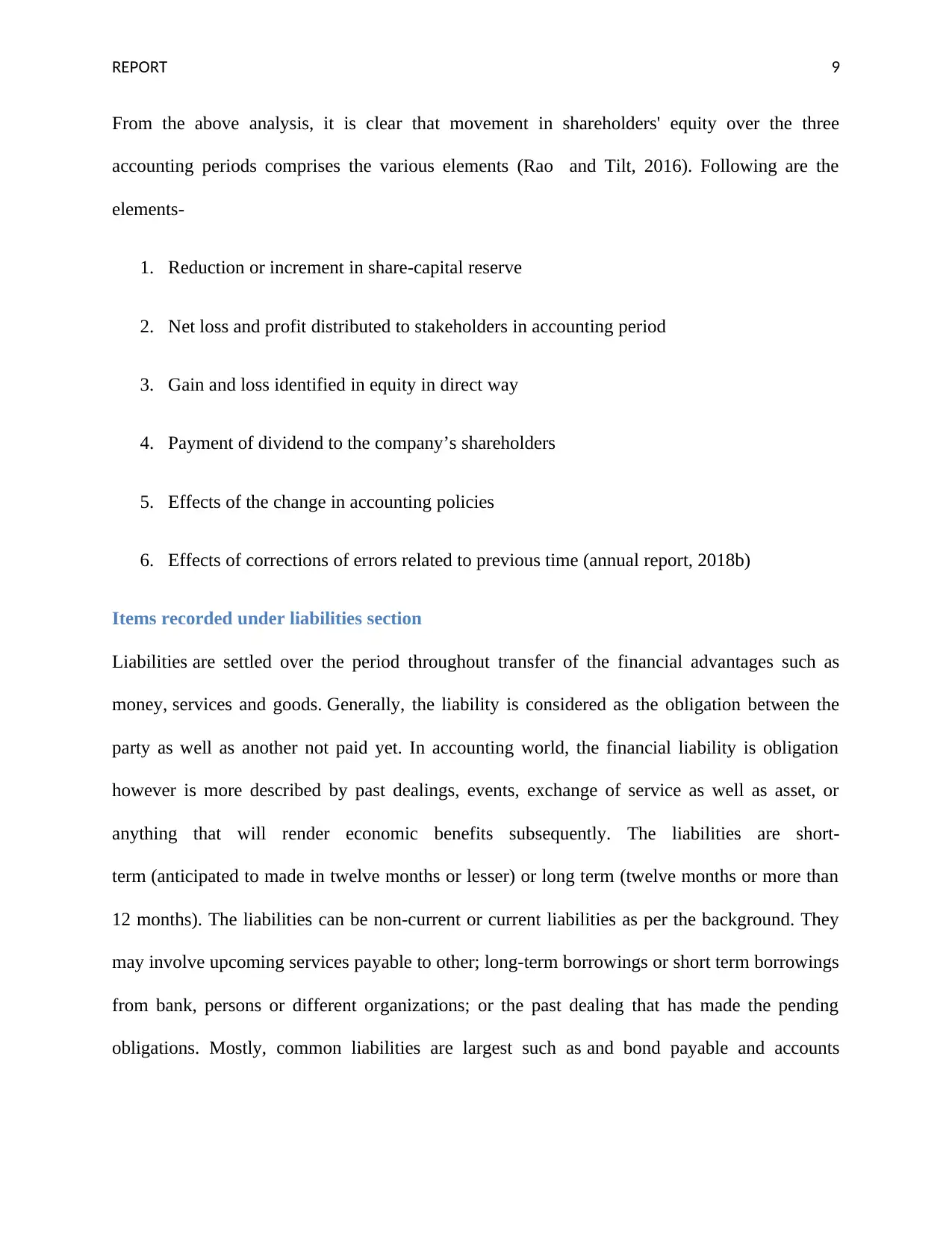
REPORT 9
From the above analysis, it is clear that movement in shareholders' equity over the three
accounting periods comprises the various elements (Rao and Tilt, 2016). Following are the
elements-
1. Reduction or increment in share-capital reserve
2. Net loss and profit distributed to stakeholders in accounting period
3. Gain and loss identified in equity in direct way
4. Payment of dividend to the company’s shareholders
5. Effects of the change in accounting policies
6. Effects of corrections of errors related to previous time (annual report, 2018b)
Items recorded under liabilities section
Liabilities are settled over the period throughout transfer of the financial advantages such as
money, services and goods. Generally, the liability is considered as the obligation between the
party as well as another not paid yet. In accounting world, the financial liability is obligation
however is more described by past dealings, events, exchange of service as well as asset, or
anything that will render economic benefits subsequently. The liabilities are short-
term (anticipated to made in twelve months or lesser) or long term (twelve months or more than
12 months). The liabilities can be non-current or current liabilities as per the background. They
may involve upcoming services payable to other; long-term borrowings or short term borrowings
from bank, persons or different organizations; or the past dealing that has made the pending
obligations. Mostly, common liabilities are largest such as and bond payable and accounts
From the above analysis, it is clear that movement in shareholders' equity over the three
accounting periods comprises the various elements (Rao and Tilt, 2016). Following are the
elements-
1. Reduction or increment in share-capital reserve
2. Net loss and profit distributed to stakeholders in accounting period
3. Gain and loss identified in equity in direct way
4. Payment of dividend to the company’s shareholders
5. Effects of the change in accounting policies
6. Effects of corrections of errors related to previous time (annual report, 2018b)
Items recorded under liabilities section
Liabilities are settled over the period throughout transfer of the financial advantages such as
money, services and goods. Generally, the liability is considered as the obligation between the
party as well as another not paid yet. In accounting world, the financial liability is obligation
however is more described by past dealings, events, exchange of service as well as asset, or
anything that will render economic benefits subsequently. The liabilities are short-
term (anticipated to made in twelve months or lesser) or long term (twelve months or more than
12 months). The liabilities can be non-current or current liabilities as per the background. They
may involve upcoming services payable to other; long-term borrowings or short term borrowings
from bank, persons or different organizations; or the past dealing that has made the pending
obligations. Mostly, common liabilities are largest such as and bond payable and accounts
⊘ This is a preview!⊘
Do you want full access?
Subscribe today to unlock all pages.

Trusted by 1+ million students worldwide
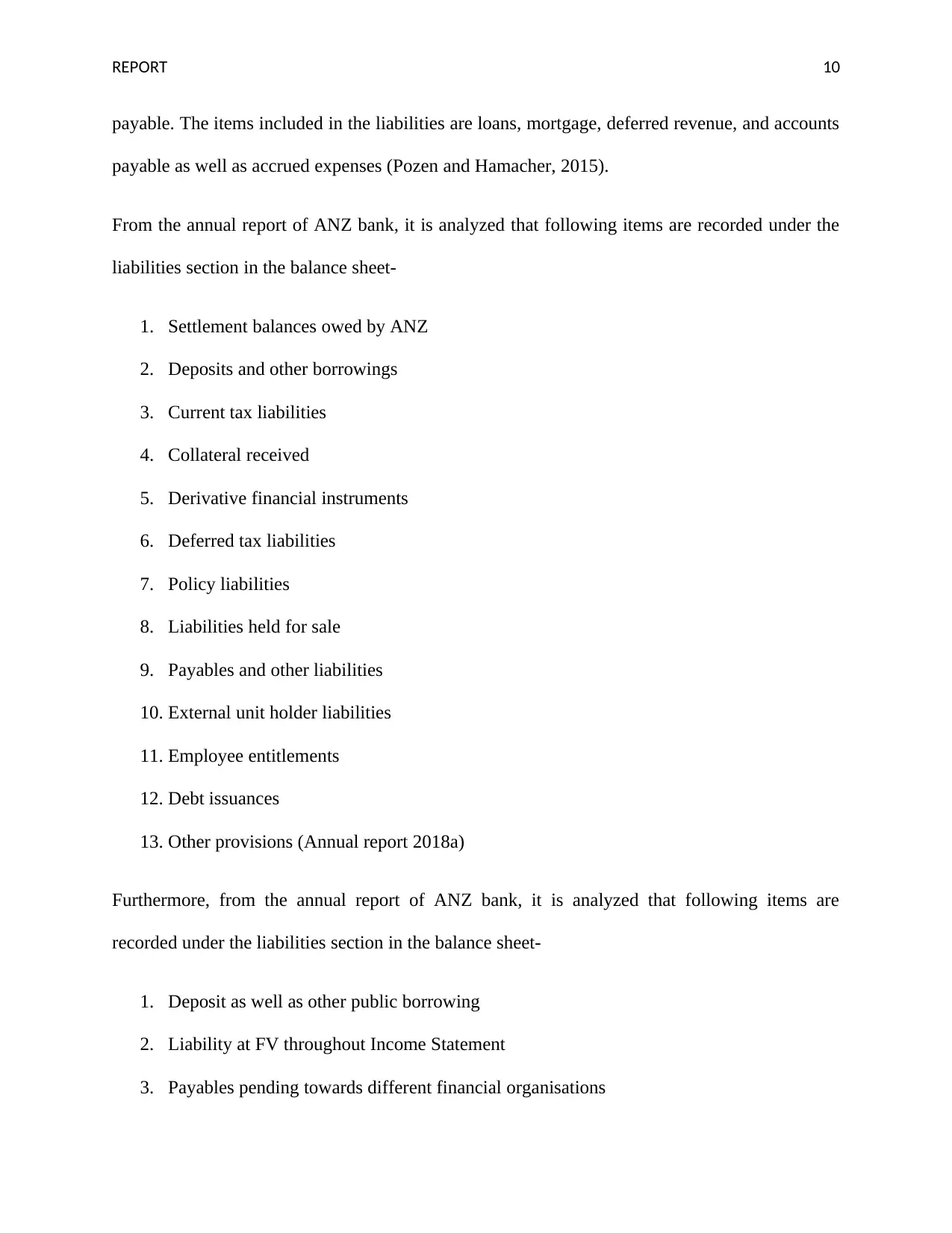
REPORT 10
payable. The items included in the liabilities are loans, mortgage, deferred revenue, and accounts
payable as well as accrued expenses (Pozen and Hamacher, 2015).
From the annual report of ANZ bank, it is analyzed that following items are recorded under the
liabilities section in the balance sheet-
1. Settlement balances owed by ANZ
2. Deposits and other borrowings
3. Current tax liabilities
4. Collateral received
5. Derivative financial instruments
6. Deferred tax liabilities
7. Policy liabilities
8. Liabilities held for sale
9. Payables and other liabilities
10. External unit holder liabilities
11. Employee entitlements
12. Debt issuances
13. Other provisions (Annual report 2018a)
Furthermore, from the annual report of ANZ bank, it is analyzed that following items are
recorded under the liabilities section in the balance sheet-
1. Deposit as well as other public borrowing
2. Liability at FV throughout Income Statement
3. Payables pending towards different financial organisations
payable. The items included in the liabilities are loans, mortgage, deferred revenue, and accounts
payable as well as accrued expenses (Pozen and Hamacher, 2015).
From the annual report of ANZ bank, it is analyzed that following items are recorded under the
liabilities section in the balance sheet-
1. Settlement balances owed by ANZ
2. Deposits and other borrowings
3. Current tax liabilities
4. Collateral received
5. Derivative financial instruments
6. Deferred tax liabilities
7. Policy liabilities
8. Liabilities held for sale
9. Payables and other liabilities
10. External unit holder liabilities
11. Employee entitlements
12. Debt issuances
13. Other provisions (Annual report 2018a)
Furthermore, from the annual report of ANZ bank, it is analyzed that following items are
recorded under the liabilities section in the balance sheet-
1. Deposit as well as other public borrowing
2. Liability at FV throughout Income Statement
3. Payables pending towards different financial organisations
Paraphrase This Document
Need a fresh take? Get an instant paraphrase of this document with our AI Paraphraser

REPORT 11
4. Derivative liabilities
5. Pending towards controlled entities
6. Bank acceptances
7. Current tax liabilities
8. Current tax liabilities
9. Insurance policy liabilities
10. Other provisions
11. Debt issue
12. organized funds unit on issues
13. Liabilities held for sale
14. Bills payable and other liabilities
Movement over three years period in items recorded under liabilities section
When absolute and relative liabilities differ highly between sectors and corporations, they may
break or create the entity as simple as the missed earning report. It can say that the liabilities
state the deep story of how the entity finances, accounts and plans. This would require paying at
the upcoming date. Various ratios are dragged from line item of liability to attain health of
company at particular point of period (Class, 2016). When bonds payable and accounts payable
make up share of the liability portion of balance sheet, the not so general or lesser considered
item must be analyzed in detail. Movement over three years in items recorded under liabilities
part is evaluated below-
ANZ Bank-
4. Derivative liabilities
5. Pending towards controlled entities
6. Bank acceptances
7. Current tax liabilities
8. Current tax liabilities
9. Insurance policy liabilities
10. Other provisions
11. Debt issue
12. organized funds unit on issues
13. Liabilities held for sale
14. Bills payable and other liabilities
Movement over three years period in items recorded under liabilities section
When absolute and relative liabilities differ highly between sectors and corporations, they may
break or create the entity as simple as the missed earning report. It can say that the liabilities
state the deep story of how the entity finances, accounts and plans. This would require paying at
the upcoming date. Various ratios are dragged from line item of liability to attain health of
company at particular point of period (Class, 2016). When bonds payable and accounts payable
make up share of the liability portion of balance sheet, the not so general or lesser considered
item must be analyzed in detail. Movement over three years in items recorded under liabilities
part is evaluated below-
ANZ Bank-

REPORT 12
Commonwealth Bank-
Commonwealth Bank-
⊘ This is a preview!⊘
Do you want full access?
Subscribe today to unlock all pages.

Trusted by 1+ million students worldwide
1 out of 21
Related Documents
Your All-in-One AI-Powered Toolkit for Academic Success.
+13062052269
info@desklib.com
Available 24*7 on WhatsApp / Email
![[object Object]](/_next/static/media/star-bottom.7253800d.svg)
Unlock your academic potential
Copyright © 2020–2025 A2Z Services. All Rights Reserved. Developed and managed by ZUCOL.





